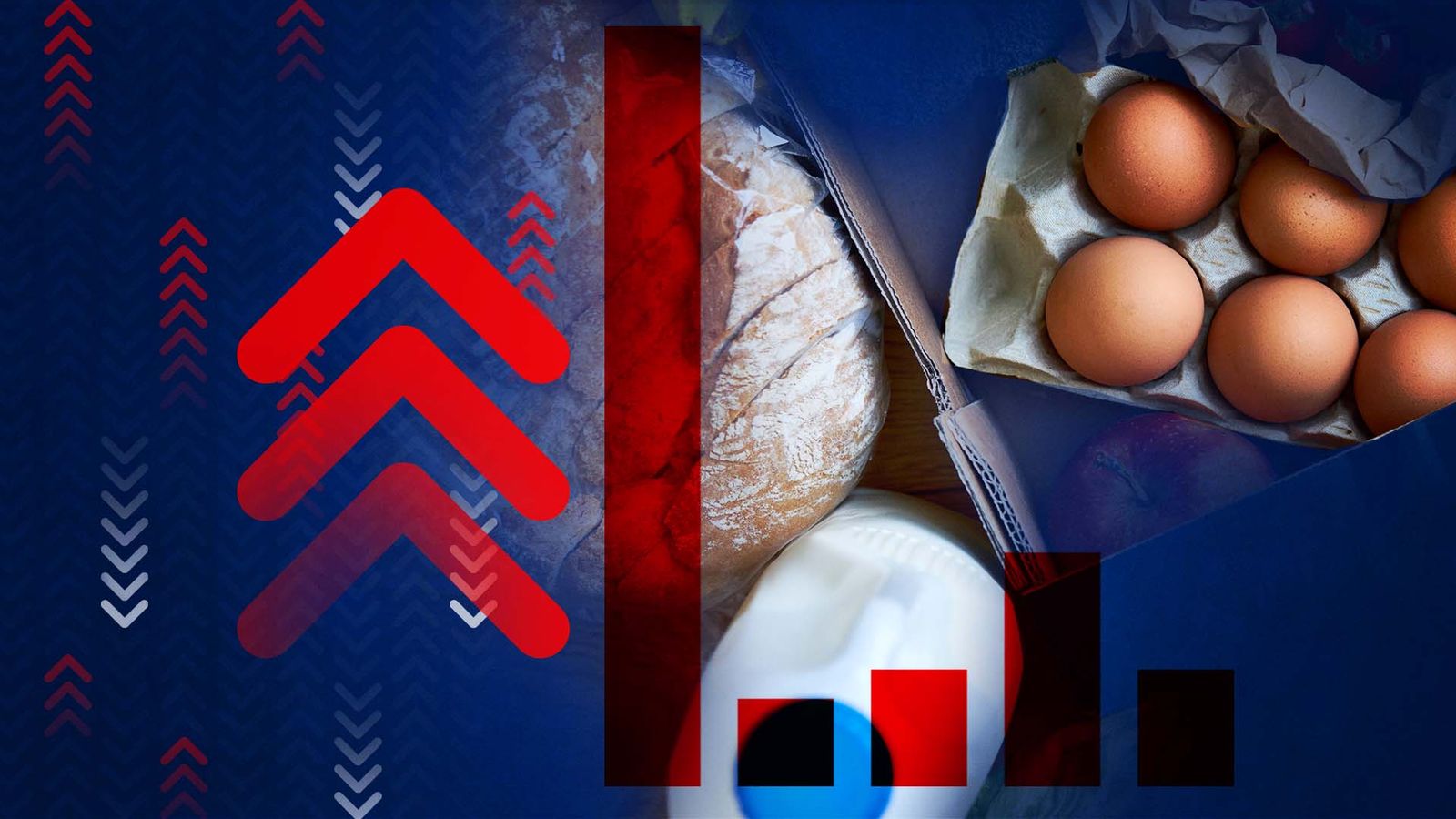The cost of food and drink increased by more than any other type of good over the past month.
Another set of staggering inflation figures from the Office for National Statistics (ONS) has revealed that food and drink accounted for almost half (44%) of inflation from June to July.
Some good news beneath today’s figures – cost of living latest
Basic goods such as milk, butter, pasta and cooking oils are among some of the steepest price hikes – along with toothbrushes and toilet roll.
But why has food and drink gone up so much now – and what about the energy crisis? Here Sky News takes a closer look at this month’s inflation figures and the explanation behind them.
Which food and drink has gone up the most?
The soaring price of food and non-alcoholic drink was the biggest contributor to CPIH inflation (the Consumer Price Index including owner occupiers’ housing costs) from June to July.
CPIH increased by 0.59 percentage points from one month to the next – of which 0.26 percentage points were exclusively down to food and drink – the equivalent of 44%.
But food and drink were also among the biggest contributors to year-on-year inflation from July 2021 to July 2022 – alongside energy and transport costs.
According to the latest ONS data, wheat-based products like bread, cereal and pasta had some of the steepest price rises compared to this time last year, alongside milk, cheese, eggs and yoghurt.
The price of meat, particularly ham and bacon, increased considerably too, alongside olive oil, other vegetable fats, jams and sauces.
On the drinks side, mineral water had the biggest jump in price, followed by fruit juices, coffee and tea.
Please use Chrome browser for a more accessible video player
Why are food prices rising now?
The war in Ukraine has left the UK and other Western countries unable to access both Ukrainian and Russian exports.
This is because Vladimir Putin’s forces have prevented goods from leaving Ukraine by sea and the UK has sanctioned Russian goods altogether.
Combined, the two countries make up a third of global wheat supplies, which are not only used to make bread, cereal and pasta, but also animal feed, which is vital for meat and dairy production.
This drop in global supply drives up prices for all of those products.
But this can take time, which is why the impact of February’s invasion may only being felt now.
Read more:
How everyday items have risen in price over the past 12 months
Poorest households see prices rise 24% faster than richest
Tom Holder, of the British Retail Consortium, told Sky News: “Just because the price of wheat has gone up today, for example, it won’t mean the price of pasta also goes up today.
“Supermarkets and other retailers try to absorb price rises and hold them down for as long as possible.
“But if costs of production, and global prices, are consistently high then they eventually have no choice but to pass some of those price rises on to consumers.”
Contracts between farmers and retailers are often arranged far in advance, he added, so there may be a delay in seeing supply chain issues reflected in prices.
The costs of electricity, gas, petrol and diesel are all still very high – and are also still one of the biggest drivers of inflation.
Food and drink production is heavily energy intensive and with 40% of British food and drink imported, transport costs are also a big part of the supply chain.
This means that eventually these costs also need to be factored into retail prices.
Has the weather changed things?
The recent heatwave explains some of the price rises in the latest inflation data.
With this July the hottest and driest for decades, the demand for products to help people stay cool appears to have been higher than a year ago – pushing up prices.
For example, the cost of a bottle of water was 22% more in July than it was this time last year.
Fans and air conditioners were up 18.2% on a year ago, with garden furniture also among the drivers of inflation – with an annual price increase of 21.1%.
Toothbrushes and toilet paper prices up
Within the “miscellaneous goods and services” category, the biggest increase in prices came from “products for personal care”.
This was mainly “toilet rolls, toothbrushes, electric hair styling appliances and deodorants“, the ONS said.
Mr Holder said that for these sorts of products, a big part of the overall costs is shipping and vehicle transport, which has increased with the hike in fuel prices.
“Manufacturers are going to have to absorb the soaring cost of shipping,” he said.
“Products that involve a lot of plastic packaging, may also be hit by a new plastic packaging tax.”










